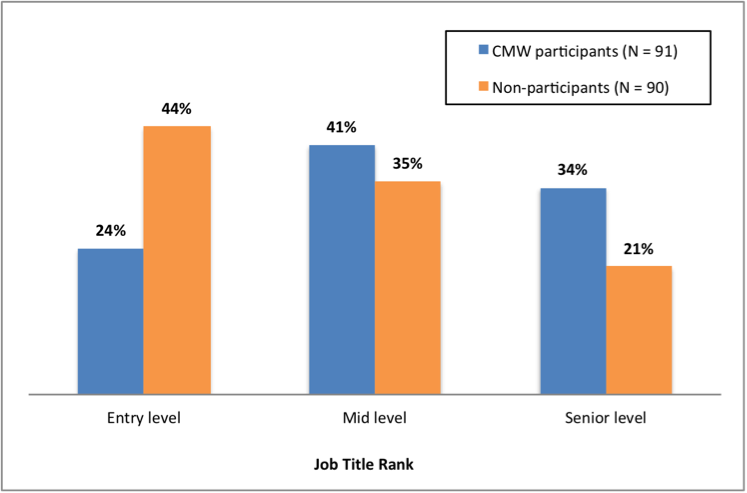Nearly 10 Years Later, CRA-W Career Mentoring Workshop Participants are More Advanced in their Careers Than Non-Participants
By Jane Stout, CERP director, and Burçin Tamer, CERP research scientist

CERP recently extracted Web data to observe the career progression of women who had participated in the CRA-W’s 2008 or 2009 Career Mentoring Workshops (CMWs) compared to a sample of women who had never participated in CMWs. We obtained the comparison sample from a population of women who earned their Ph.D.s in computer science during the same time period as the participants. We collected current career information including job titles (e.g., associate professor) and job setting (e.g., academia vs. industry/labs) for both groups. We then categorized job titles as entry level (e.g., assistant professor, software engineer), mid level (e.g., associate professor, senior engineer), and senior level (e.g., professor, principal program manager), collapsed across job setting. To test for a systematic difference in job rankings between workshop participants and the comparison group, we ran a 2 (Group) x 3 (Job Title Rank) Chi-squared test and found a statistically significant difference in rankings across the two groups, χ2 (2, N = 181) = 8.46, p < 0.05. Specifically, CMW participants were less likely than non-participants to be in an entry level position, p < .05, and more likely to be in a senior level position than non-participants, p < .05.
Note: It is possible that our findings are explained by factors outside of the CMWs. For instance, our analysis did not account for the rigor/prestige of the institutions where women obtained their Ph.D. This concern is alleviated to some degree by the fact that our comparison sample was randomly selected from the complete list of Ph.D. programs in the field of computer science during a given period of time in the United States. This list was obtained from the ProQuest Dissertations and Theses Database, which covers almost all North American Ph.D.-granting institutions. As a result, we do not expect there to be a systematic bias toward a given type of institution in the way that there would be if we were using a convenience sample of a subset of institutions. Also, compared to non-participants, CMW participants may be more proactive in taking steps to advance their career (e.g., by attending a career mentoring workshop), which could explain the pattern of results reported here. Further, the people in the comparison group were only those we were able to find via current job information on the Web. This means women who did not have any public information online were excluded from our data. That said, we suspect this may actually increase the validity of our conclusions, assuming it is easier to find public information on people who are in more versus less prominent positions in their field. Given these and other possible forms of bias in our data collection method, the current finding should be interpreted with caution. A detailed report of our Web data extraction and categorization method is available upon request.
 This infographic is brought to you by the CRA’s Center for Evaluating the Research Pipeline (CERP). CERP provides social science research and comparative evaluation for the computing community. To learn more about CERP, visit our website at https://cra.org/cerp/.
This infographic is brought to you by the CRA’s Center for Evaluating the Research Pipeline (CERP). CERP provides social science research and comparative evaluation for the computing community. To learn more about CERP, visit our website at https://cra.org/cerp/.



